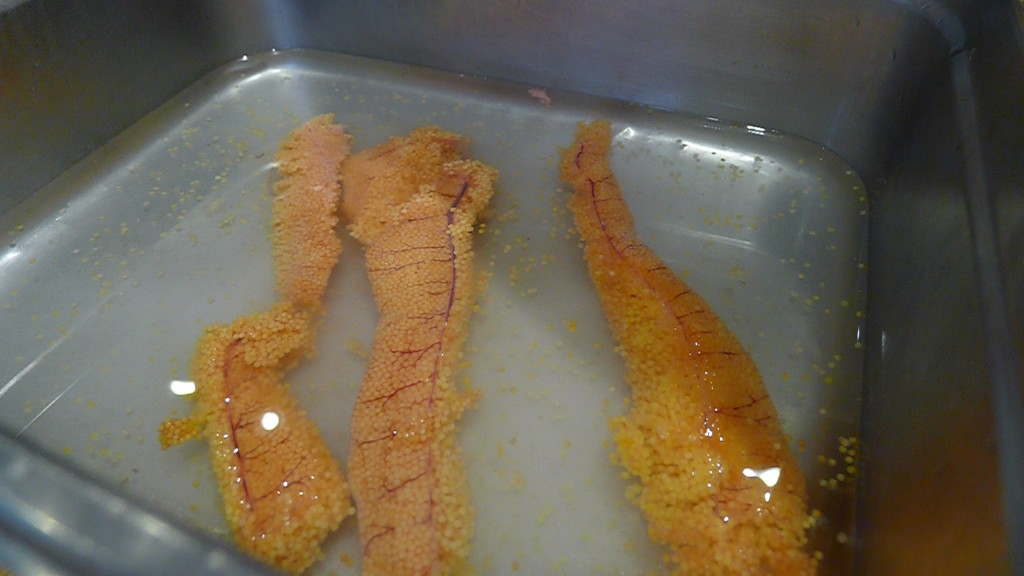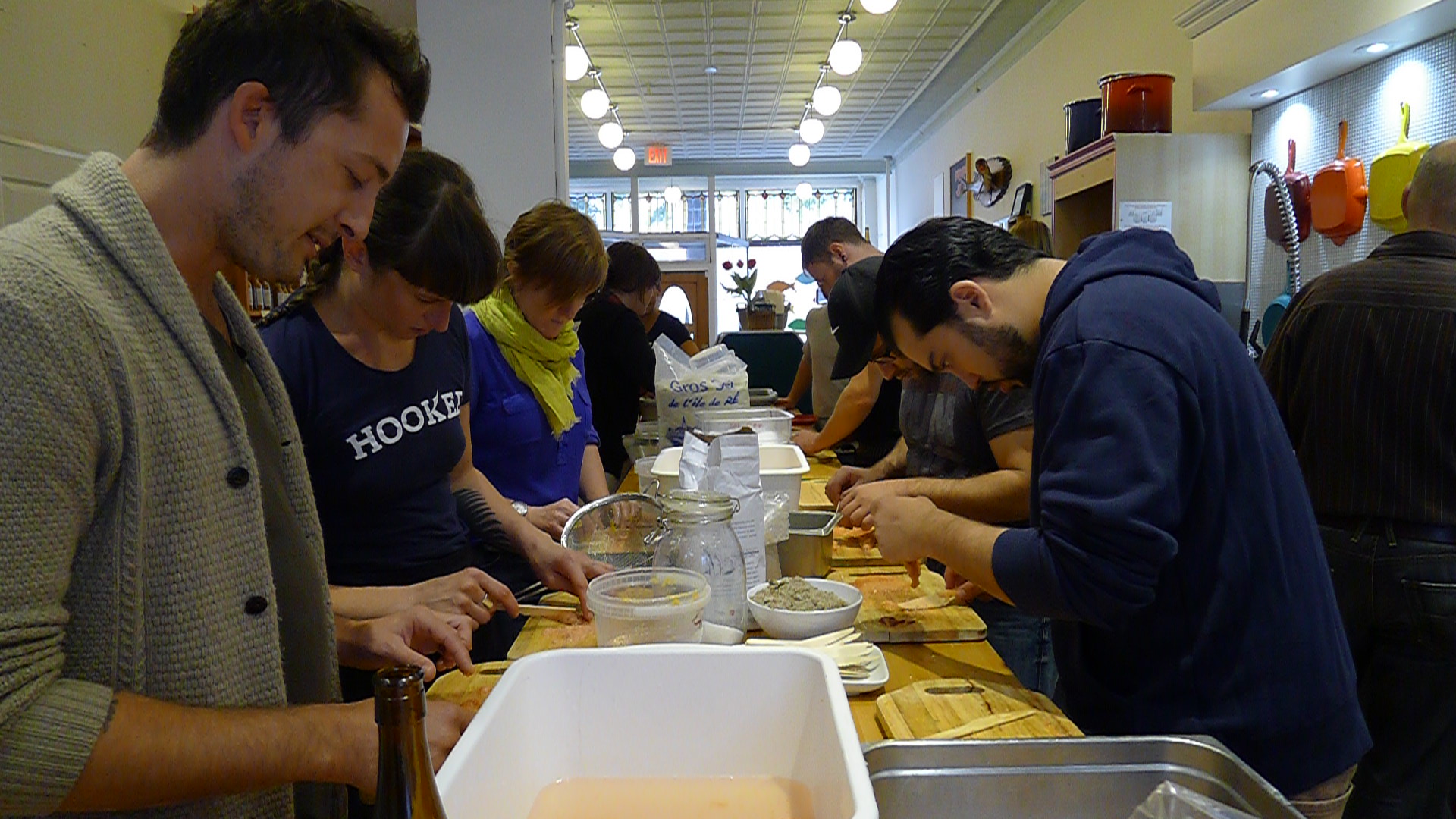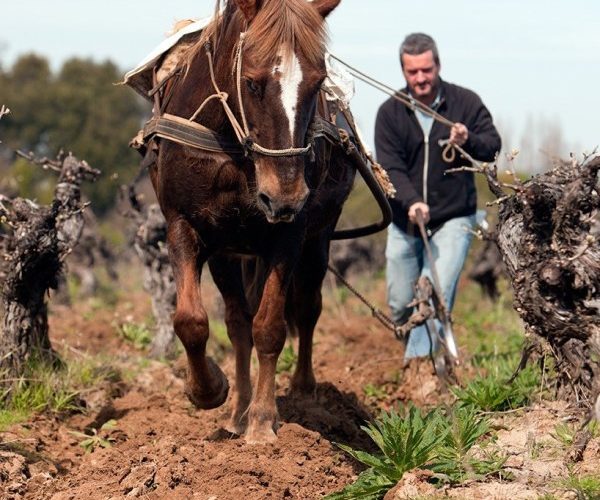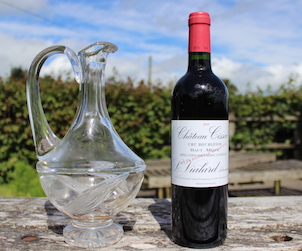
Some whitefish roe brining… and looking rather tasty already.
Question: So what do you think it would take to get Dan Muia (Mogette Bistro), Rob Gentile (Buca), Chris McDonald (Cava), Carolyn Reid (Scaramouche), Rebekka Hutton (Alchemy Pickle), Justin Courneya (Actinolite), Taylor Meekin (Air Canada Centre), Giacomo Pasquini (Vertical), Charlotte Langley (Catch), Guillermo Russo (Arcadian Court), Sunny Stone (Hooked), Grant Van Gameron (Bar Isabel), Andrew Poulsen (Hooked), and Marc St. Jaques (Auberge de Pommier) all gathered in the East End on a Autumnal Monday morning?
Answer: Host a Caviar Making Workshop for Slow Fish Month.
We spoke to Dan and Kristin Donovan at Hooked about just what they were up to…
Good Food Revolution: Dan and Kristin from Hooked, please tell us a little about Slow Fish and Slow Fish month.
Dan Donovan: Slow Fish is a campaign – or a particular focus really, of Slow Food worldwide. The objective of the campaign is to champion the ideals of good, clean fair in all areas of seafood; conservation, resource privatization, and support of the food culture around seafood. In different countries the campaign focuses on local issues. Last year in Canada, the Slow Fish Campaign was adopted as a national initiative in recognition of the integral role of fishing in Canadian culture. Because we are still a small group, we decided to focus much of activity into October “Slow Fish Month” in order to get as much attention as possible. This year our campaign will focus on policy issues related to the privatization of our resources that is currently underway in Canada. We encourage all Canadians to become better informed in this area and we welcome all who are interested to contact their local Slow Food group and become involved.
GFR: And how did the idea for a Caviar Workshop and Roe Down come about?
DD: The caviar workshop grew out of a recognition that an ancient technique of preserving fish eggs (roe) is quickly disappearing. Due to increased and more complex regulation, and competition from larger international concerns, local Ontario or Canadian processors are leaving the business. As a result, our chefs are driven to use imported products and our fishermen have fewer markets to sell to. Often, the roe is either discarded or sold to petfood companies. Although it was conducted as a workshop – the goal was really more like a quilting bee, but for fish roe; to bring together a bunch of talented chefs and create something wonderful out of scraps.
GFR: So what you are saying is that all of this roe usually goes to waste or finds itself in petfoods? Why is that?
DD: Most people are not aware of the intense demand that pet food, aquaculture, and now poultry (omega3 eggs) feed manufactures, exert in the fish market. This intense demand is causing distortions of local ecosystems at the lower tropic levels – as feeder fish like anchovies, sardines, herring and mackerel are increasingly being diverted from the human food system into the industrial feed system. The result is a void in the food chain which is often filled by jelly fish which perversely reduce feed for higher predators and introduces a predator of their eggs at the same time.
GFR: I was under the impression that Caviar was only the salt-cured eggs of Sturgeon… am I wrong here? (or am I just being a pedant?)
DD: Strictly speaking yes. However, unlike say Champagne or Bordeaux, there is no official body that protects the name caviar. The US has adopted the “sturgeon only” position for import documentation purposes as has the UN and some signatories to CITES (Convention on International Trade in Endangered Species). A new name would be a good thing – maybe the GFR could run a competion? Perhaps the key reason to make a distinction and also the best reason to make efforts to ensure a domestic industry is the precarious status of wild sturgeon populations. With few exceptions, sturgeon are considered critically endangered worldwide, and therefore having a sustainable alternative to sturgeon caviar is a good development all around.
GFR: Would you please take us through the basic steps of preserving roe?
Kristin Donovan: Sure! The first fall we opened, our trout grower brought us roe. I read up on the making of caviar, tried out a few methods, different salt concentrations, and couldn’t believe the result. It was beautiful, so we ordered more. Little did I know that we would then get 30 lbs of trout and another 20 lbs of whitefish roe. It is a time consuming, delicate and backbreaking process when undertaken to that degree with only one set of hands. Through all of the eggs, we came up with a recipe that works. It does vary, depending on roe size however.
Equipment: kosher or sea salt, water, 2 large bowls or small plastic bins, a wooden cutting board, popsicle sticks or wooden chopsticks, a fine strainer, small mason jars.
1. Make a brine. 1/2 cup kosher or sea salt to 1 litre cold water. Mix until the salt dissolves completely. Immerse the skein of roe for 5 minutes. This process tightens the membrane around the eggs to facilitate their removal.
2. Have a small bin of warm water (105-120 degrees F) handy. Remove the skeins from the brine and into the warm water. Gently massage the skeins with your hands to remove as many eggs as possible. Remove the skeins to the wooden board and using the popsicle stick, gently scrape the remaining eggs from the membrane. Skim the surface of the warm water bath to remove any floating scales or veins. Strain to remove all water.
3. Make another brine. For a larger roe (trout or salmon): 1/2 cup salt to 1 litre water. For a smaller roe (whitefish, shrimp, uni): 1/4 cup salt to 1 litre water. Immerse the eggs for 5 minutes. Begin tasting the eggs at this time to determine your desired salinity point. We’ve found that 8-10 minutes for larger roe is usually ideal, and 6-7 minutes for smaller roe is sufficient.
4. Sterilize jars and fill to the first line. We vacuum seal our jars for a longer shelf life. The caviar will keep 5-7 days in the fridge without sealing, 2 weeks with a seal. Once packed in jars, it can be frozen for up to 6 months.
GFR: Once preserved like this what is the approximate shelf life?
KD: The caviar will keep 5-7 days in the fridge without sealing, 2 weeks with a seal. Once packed in jars, it can be frozen for up to 6 months.
GFR: It was superb to see all of these great Toronto chefs turn up at the workshop to learn about making preserved roe. I got the impression that most of them had little to no experience preserving the stuff?
KD: It was amazing to see the turnout. We were so excited. I was a little surprised that so few had made caviar before. Everyone was very honest about their experience (or lack thereof) and keen to learn. They each admitted to having attempted it once or twice. Rob from Buca had made bottarga (salt cured roe) with great success.
GFR: And so it should be interesting to see what each Chef chooses to experiment with… I saw all sorts of interesting ideas at the workshop… adding Beau’s Lugtread, Saké, chili flakes… I’m not sure how all of those will turn out though. Wouldn’t the addition of any alcohol jeopardize the integrity of the egg walls?
KD: I have admitted to being limited in my creativity with caviar, having mainly worked with a basic brine solution to get a fairly neutral, albeit delicious product. The chefs were like kids in a candy store, experimenting with everything we had on hand, from dill pickle liquid to dashi broth. I think we’ll have to wait and see what works in their experimentation. I would think that the process they would use is similar to the above, but that the flavouring could be added a la minute, so that the egg walls remain intact. We’ll need to ask them if they had issues with degradation of texture…
GFR: You were also speaking of drying the roe to create Botargo, a Mediterranean speciality. Is that something that you have had much success with?
KD: I’ve only tried it once before. I’m in the midst of a new batch, which is looking good! As mentioned above, Rob Gentile has made it with terrific success. I believe he cured lumpfish roe. He’s lucky though, Buca has a ‘curing room’ with a set cool temperature and humidity;)
GFR: And so all of this fascinating invention and experimentation with the preservation of roe is leading up to a competition with a Grand Finale is it not?
KD: It is! October 29th, we have the JUDGEMENT. Each participating chef will submit 3 types of caviar for tasting. In the next few weeks, they will be able to experiment with the following roe (all from small, well managed fisheries): whitefish, pickerel, trout, char, coho salmon, uni, Chedabucto Bay shrimp and side stripe prawn. Our panel of judges (including Christine Cushing, Amy Rosen, Jim Cuddy, and James Chatto), will taste away to decide the best rendition of caviar. There will be 3 categories and different criteria that will need to be met. Beau’s has been a terrific sponsor to Slow Fish and will be our beer sponsor for the evening. We will have two types of Lustau sherry as well as local sake to taste with. It is going to be lot of fun.
GFR: Now that sounds just splendid! I’m looking forward to it that’s for sure. Thanks again!
 Edinburgh-born/Toronto-based Sommelier, consultant, writer, judge, and educator Jamie Drummond is the Director of Programs/Editor of Good Food Revolution… And yes, he’ll be playing the role of MC at the Caviar Cup Roe Down!
Edinburgh-born/Toronto-based Sommelier, consultant, writer, judge, and educator Jamie Drummond is the Director of Programs/Editor of Good Food Revolution… And yes, he’ll be playing the role of MC at the Caviar Cup Roe Down!








Trackbacks/Pingbacks